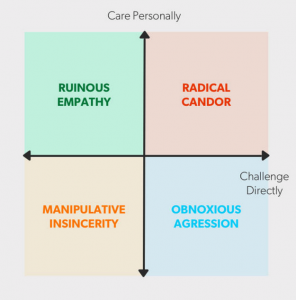RADICAL CANDOR: IS IT EVER OK TO USE THE WORD “STUPID” WHEN GIVING FEEDBACK?
Is it ever OK to use the word “stupid” when giving feedback? Professional business coach Kim Scott offered great perspectives on this question when she spoke at First Round Capital’s late 2015 CEO Summit.
Once upon a time, Scott presented her recent business results to her manager’s bosses: Google’s Sergey Brin and Larry Page. Hugely impressed, the two offered the young executive more resources. Afterwards, Scott’s own manager, Sheryl Sandberg, shared what she had liked about Scott’s presentation. Then added “But you said um a lot.” And offered her a Google-funded public speaking coach.
Scott verbally brushed off this comment, still feeling on top of the world. Finally, Sandberg said “You know, Kim, I can tell I’m not getting through to you. I’m going to have to be clearer here. When you say um every third word, it makes you sound stupid.” At which point, reports Kim, the message DID sink in.
Scott feels that Sandberg’s bluntness was an example of kindness, in retrospect. She needed that guidance.
TOUGH FEEDBACK ONLY WORKS IF PROVIDED IN THE RIGHT CONTEXT
Sandberg got away with her feedback with zero relationship or trust damage only because it was given in a context of “caring personally.” Sandberg had encouraged Scott to take time off to care for a sick relative and had done “a thousand” other things that showed she was invested in Scott as a person and a professional. And she offered tangible support in the same breath she offered her blunt critique.
Scott now divides the world of business relationships into 4 quadrants. The vertical axis of her graph (above) is what she calls the give-a-damn axis: how much do you, as a leader, show you care about, like, and respect the other person? The horizontal axis is about communicating guidance with candor and directness, even when it is difficult for the other person to hear. She contends the most successful leaders live at the corner of “Caring Personally” and “Challenging Directly.”
When I work with leaders in my programs, they sometimes receive feedback from colleagues that they are either nice-but-lacking-spine or the opposite: blunt-but-not-so-nice. They squirm. “Do I need to be “less nice?” the first group asks. The second group wonders if they need to stop being so blunt and direct.
Generally, I say absolutely not. Keep what’s good, whether it is the niceness, or the directness. Then develop much more of the other thing.
DON’T MAKE THE FOOL’S CHOICE
It’s a myth that leaders need to choose between being the lovable manager, or the challenging manager. Ideally — like Sheryl Sandberg– we want to be BOTH types of manager simultaneously. Showing we care through trust-building words and actions becomes our relationship “money in the bank,” like it was for Sandberg. This builds a relationship atmosphere where others will respond well, not poorly, to even the toughest of feedback.
Scott suggests that the “overly nice guy” manager who cares but isn’t direct with feedback brings “Ruinous Empathy” to his or her work relationships – and says that if a leader can’t master “Radical Candor” she prefers “Obnoxious Aggression” (the lower left quadrant) where people feel highly challenged, but don’t feel much love. I differ from Scott there. Maybe at a prestigious workplace like Google, this works and doesn’t quickly send the troops packing for greener and friendlier pastures. But at many organizations, employees (especially millennials) don’t stick around if the “challenge factor” isn’t accompanied by adequate caring & respect.
In any case, please don’t fall for what I call the Fool’s Choice: the common notion that a leader can’t be both TOUGH and CARING simultaneously. Think back: you’ve probably experienced both qualities — in spades — working for each favorite past or current boss.
WHERE DO YOU STAND?
If you’re unsure which relationship muscles you need to strengthen or which part of Scott’s graph (above graphic) you spend most of your time in, Scott offers a radical idea. Explain her chart to your team, then ask each person to consider which quadrant their most recent interaction with you fell into. Provide a way for them to write their answer down and get it to you, with confidentiality preserved. In so doing, you have a spectacular opportunity to show your team what it looks and sounds like to solicit honest performance feedback, then receive it with curiosity, openness, and gratitude. And to ensure you’ve got both the “edge” and the soft touch that managing human beings requires.
 3 Sneaky Excuses for Procrastination: Are You Guilty?June 15, 2024
3 Sneaky Excuses for Procrastination: Are You Guilty?June 15, 2024 10 Days and 34 Words to Better RelationshipsJuly 15, 2024
10 Days and 34 Words to Better RelationshipsJuly 15, 2024




1 comments